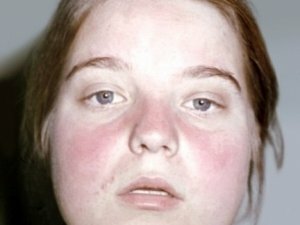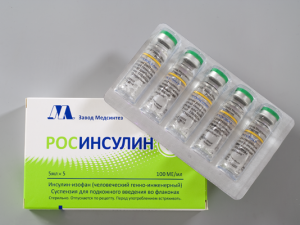Hypothyroidism: signs, causes, diagnosis
 This or that disease of a thyroid gland can be shown by increase of functional activity of a gland. For their designation, the Greek terms hypo-( sub, bottom) and hyper-( above, top) thyroidosis are used. The latter is often replaced by the word thyrotoxicosis. Most likely, this is due to the fact that all the symptoms depend on the excess production of hormones, and not on the appearance of any toxic substances.
This or that disease of a thyroid gland can be shown by increase of functional activity of a gland. For their designation, the Greek terms hypo-( sub, bottom) and hyper-( above, top) thyroidosis are used. The latter is often replaced by the word thyrotoxicosis. Most likely, this is due to the fact that all the symptoms depend on the excess production of hormones, and not on the appearance of any toxic substances.
Hypothyroidism
The main signs of a decrease in thyroid function are a rare pulse and an increase in heart size. The pulse of a person with hypothyroidism is usually less than 70 beats per minute. There may be either low or high blood pressure. With more severe course or prolonged existence of hypothyroidism, the cholesterol content is also increased, which can worsen the course of angina pectoris. Sometimes, in severe conditions, there may also be a weakening of the heart muscle and a development of heart failure. Fortunately, this is rare, and the existence of severe hypothyroidism should be long enough. Consider the changes that occur in this state.
Dimensions of the thyroid gland
The thyroid gland is usually increased due to a chronic inflammatory process, especially with autoimmune thyroiditis. But sometimes because of the expressed process of destruction of a tissue of a gland its sizes can decrease, and, finally, the sizes of a gland can be changed if the reason is the operative intervention performed earlier.
Skin
Skin can become dry and coarsened to such an extent that it begins to peel off when you scrape it. Cracks appear on the knees and elbows. The skin acquires a yellowish tinge, which is due to the presence of carotene, normally transferring to vitamin A, but with hypothyroidism this process is slowed down. Reduced heat build-up pushes the body toward the desire to retain heat for the internal organs, so the skin becomes cold. It may appear white spots, which is associated with a local loss of pigment( vitiligo).
Nails and hair
Nails become more brittle, the appearance of lines is characteristic, sometimes expressed in such a degree that manicure is simply impossible.
Hair becomes dull and thin, often dry and brittle. Because of this, you have to constantly use nutritious balms. Intensive hair loss leads to baldness.
Other hair falls: on the body, arms, legs, pubic, eyebrows, eyelashes.
Low expression, facial expression, slowed, slurred speech, hoarse voice
Changes due to swelling of the fiber and tongue and pressure of the enlarged thyroid gland on the throat nerves.
Slow growth in children
Often, the mother, wondering why her twelve-year-old child does not look more than 9 years old, leads him to a doctor who, after carrying out the necessary studies, finds out that the cause of everything is an insufficient function of the thyroid gland.
Complaints against patients with hypothyroidism :
Increased chilliness
The patient can not find enough warm place and often wonders why it is always cold here. Even in the summer wears warm woolen clothes. It feels more comfortable in hot weather, wet weather, and can not sweat.
Fatigue and drowsiness
A classic symptom of hypothyroidism is marked sluggishness and weakness. The patient always wants to sleep, even if the night before last he slept 12 hours in a row.
Digestive problems and weight gain
Intestinal motility deteriorates, leading to constipation, belching, poor appetite and heartburn. This is due to the fact that the eaten food passes through the stomach slowly, and hydrochloric acid is thrown into the esophagus.
Pain, stiffness in the joints and muscles
Often with hypothyroidism, convulsions and muscle pain are noted. They are so strong that they do not allow you to sleep at night, and the patient sometimes seems to have a joint disease. Note, after the elimination of hypothyroidism, not all phenomena disappear.
Often there is a violation of muscle coordination and the patient feels so constrained that even he can not perform simple movements.
Menstruation failure, discharge from the nipples of colostrum
Monthly become more abundant and frequent than normal. Hypothyroidism can cause an increase in the production of prolactin, which is responsible for the formation of human milk.
Causes of development of hypothyroidism
They are numerous, and most often - is an autoimmune thyroid lesion, known as Hashimoto's thyroiditis, in which cells are destroyed by the patient's lymphocytes and antibodies that appear in his blood.
Treatment of hyperthyroidism can also lead to an excessive decrease in thyroid function. This is especially often observed after treatment of diffuse toxic goiter with radioactive iodine. To the same result can lead and external irradiation of the head and neck with radio or X-ray therapy.
Hypothyroidism also develops after surgical interventions, when the entire thyroid gland or a significant part of it is removed.
Sometimes a child is born without a thyroid gland, and then there is an inborn hypothyroidism, which is noted in 10% of cases.
And, finally, hypothyroidism can develop due to the disease of the pituitary gland, a gland that regulates the formation of hormones by the thyroid gland.
But in the absence of such extreme factors, a decrease in thyroid function may occur. Many common food products can cause hypothyroidism if you consume them in significant amounts, especially in conditions of iodine deficiency. These products are called "zobogens", because along with hypothyroidism they cause an increase in the thyroid gland. Their action is that they block the transition of thyroxine( T4) to a more active odorium triiodothyronine( T3).The most common of these products are: cabbage head, color and Brussels, turnip, corn, almonds.
The occurrence of hypothyroidism may result in the administration of certain drugs, the mechanism of action of which corresponds to that described above for food.
These drugs include:
- steroids, such as prednisolone;
- amiodarone, a medicine used for heart disease;
- antithyroid drugs, such as mercazolil and propylthiouracil, used to treat hyperthyroidism;
- lithium preparations used in psychological practice;
- propranolol is a beta-blocker used for cardiac arrhythmias.
Diagnosis of hypothyroidism
A doctor examining a patient who presents a complaint and has the symptoms described above, assigns studies to confirm the diagnosis.
The results of two of these are the most significant:
- serum free thyroxine( FT4) content, which is below normal;
- level of thyroid stimulating hormone( TSH), which, on the contrary, exceeds normal values.
After confirmation of the diagnosis, it is necessary to start treatment of the disease.
Treatment of hypothyroidism
Treatment is simple. Patients are prescribed replacement therapy with thyroid hormones. Today, synthetic hormones are used everywhere, and not preparations prepared from the thyroid glands of animals, as it was before.
The correctness of the choice of dose is controlled by the level of TSH.It is not always possible to select the right dosage right away. If the amount of the hormone is too high, the patient may develop hyperthyroidism, if not enough - hypothyroidism remains untreated.
The dose selection usually takes more than a month and requires regular monitoring studies of the TSH level.
Stay healthy!



